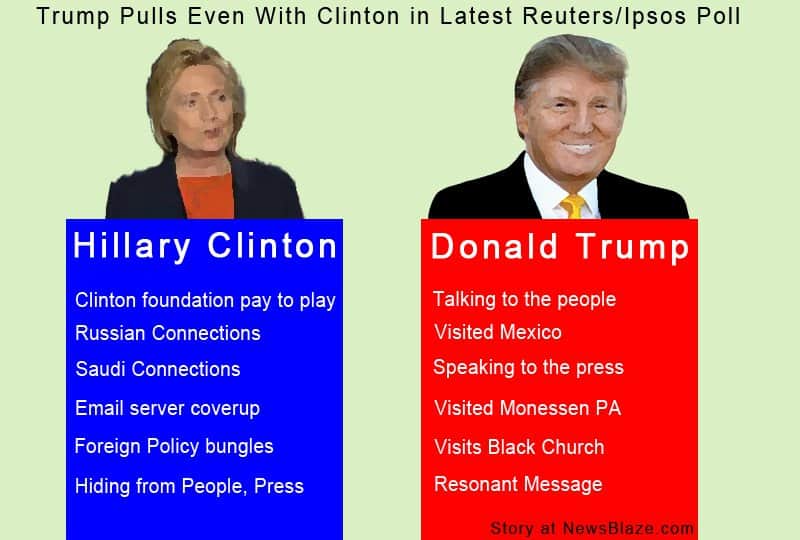The memory of the 1980 presidential campaign between former two-term California Governor Ronald Reagan and Incumbent President Jimmy Carter is alive and well in 2016’s presidential race. To the utter amazement of most pollsters, Republican presidential candidate Donald Trump has pulled into an effective tie with Democratic rival Hillary Clinton.
Trump has effectively erased a critical deficit as he has successfully consolidated support among his base and independents likely to vote in November. The poll was conducted by the highly respected and accurate Reuters/Ipsos national tracking poll released Friday.
The survey produced some astonishing numbers. Forty percent of likely voters support Trump and 39 percent backing Clinton for the week of Aug. 26 to Sept. 1. As the personal server and Clinton Foundation scandals slowly enter the campaign of Hillary Clinton, her support has dropped dramatically in the weekly tracking poll since Aug. 25, eliminating what had been an eight-point lead for her.
The scenario is reminiscent of the 1980 fall campaign of Ronald Reagan. The media declared him a dead duck shortly after Labor Day. There was a strong undercurrent of support for Reagan that later surfaced as a solid voting base of millions of angry voters.
Similar to Reagan, the real estate mogul’s surprising surge came as Republican support for their party’s candidate jumped by six percentage points over the past two weeks, to about 78 percent. But that is still well below former 2012 presidential nominee Mitt Romney’s 85 percent support in the early fall.

The Reuters/Ipsos poll is conducted online in English in all 50 states. The credible poll surveyed 1,804 likely voters over the course of the week; it had a credibility interval, a measure of accuracy, of three percent. The operative words are “likely voters.”
Polling in general has found Clinton’s lead shrinking for the past few weeks. She is presently ahead by three and six percentage points. A variety of polls show the race even tighter. The reality, as of last Friday, indicates Clinton was on track to win the Electoral College, by about 332 votes to 206.
But, not unlike 1980 where Carter became overwhelmed with his inability to free American diplomats held hostage by Iran, Clinton has come under renewed criticism over her handling of classified information while serving as U.S. secretary of state. To make her numbers sink even lower, the family’s charitable foundation has come under new attack for the donations it accepted while Clinton served in the Obama administration.
Similar to Carter’s Rose Garden strategy in 1980, Clinton hasn’t been campaigning as actively as Trump. Her campaign handlers’ rope-a-dope strategy includes the stark fact that Hillary has not held an open press conference in over 280-days. The fear is the questioning will add further national spotlight on her lying and corruption issues that will damage her further. She is providing interviews on a singular basis where the corruption issues can be handled with talking points and vague innuendo.
Trump has reshuffled his campaign leadership, and sought to broaden his appeal to moderate Republicans and minorities. He is openly reaching out to African Americans, and has taken steps, including a meeting this week with Mexican President Enrique Pea Nieto, to reach out to immigrants. His statesmanship is rattling the Clinton machine with his nontraditional invitation to traditionally solid Democratic-based voters. Meanwhile, Clinton is not projecting an honest persona to more and more dubious voters.
Among likely voters, the former secretary of state’s disapproval numbers grew to 57 percent, compared with Trump’s 54 percent. It is her worst showing on that metric in a month.
Larry Sabato, director of the University of Virginia Center for Politics, commented, “There has been a closing that’s completely natural. Every four years, you have two national party conventions that produce a bounce of varying sizes. Clinton got a substantial bounce this year that lasted for a full month. It’s usually gone around Labor Day, and by then we’ll be where we should be, which is right around four to five points.”
Ronald Reagan, labeled reckless cowboy, warmonger and grade B actor, was in a similar situation at the same time as this Trump campaign, in 1980.
In the Reuters/Ipsos poll question that included alternative-party candidates, Clinton and Trump were tied at 39 percent. Seven percent supported Libertarian candidate Gary Johnson, and two percent supported Jill Stein of the Green Party.
There was a third candidate in 1980; his name was John Anderson. His candidacy was later reported to have been a key factor in the landslide victory for Ronald Reagan that only one poll anticipated just one week before the election. The outcome was later understood by all pollsters. Carter played the “rope-a-dope” strategy while Reagan reached out with his message of less government and his “shining light” appeal that the angry American voter resonated with.







